Quest Warrior Mulligan Strategy & Guide
The mulligan section is divided into two parts – against fast decks and against slow decks. Fast decks are generally the Aggro decks (e.g. Odd Face Hunter) or high tempo Midrange decks (e.g. Even Paladin). Slow decks are slower Midrange and Control decks.
Vs Fast Decks
Important: You do not want to keep Fire Plume's Heart against Aggro! Always keeping your Quest is a common mistake – you often want to mulligan it away. A good example would be Odd Paladin – Quest is absolutely pointless in that matchup. Even if you finish it in time, the flood of tokens will make your new Hero Power almost useless. Tempo Mage is another example – it’s a matchup in which you win by surviving, and 2 Armor Hero Power is much better for that matter. If they don’t get Aluneth, you outarmor them, and if they do, you just need to stall long enough for fatigue to kill them – of course, 8 damage Hero Power might come handy sometimes, but you will have a higher win rate by getting an extra card in mulligan.
Higher Priority (keep every time):
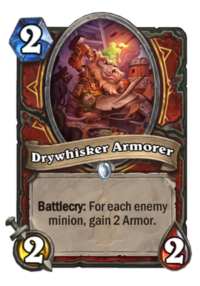
- Drywhisker Armorer – 2/2 that will usually give you 4-10 Armor? It’s a great keep in all of those aggressive matchups, especially board-flood ones like Odd Paladin.
- Warpath – Keep in aggressive matchups, thanks to its flexibility. You actually often use it on Turn 2 as just a Whirlwind, but if you need 2 AoE damage on T4 or 3 AoE damage on T6 it’s also good.
- Acolyte of Pain or Stonehill Defender – The 1/3 and 1/4 stats of those minions are actually good against lots of 1-drops. Stonehill Defender can stop some damage while getting you another Taunt to curve with, while Acolyte of Pain can draw multiple cards. Acolyte of Pain is best if you have Warpath or Blood Razor follow-up, though.
- Tar Creeper – Great defensive 3-drop – it should at least slow down the opponent’s aggression by quite a bit.
- Blood Razor – Hands down the best card you can have against Aggro. It often clears the board on the turn you play it AND makes your opponent’s turn difficult, as he can’t play any 1 health minions.
Lower Priority (keep only if certain conditions are met):
- Cornered Sentry – With Drywhisker Armorer. Summoning three extra minions for your opponent is +6 Armor, and that’s massive. The only deck I wouldn’t do it against is probably Shaman, because you can get punished with Flametongue Totem.
Vs Slow Decks
Higher Priority (keep every time):
- Fire Plume's Heart – Against slow decks, Quest is your main win condition, so it’s an auto-keep .
- Acolyte of Pain – You want to cycle through your deck as quickly as possible, so Acolyte is a great keep.
- Stonehill Defender – You want to finish your Quest as fast as possible, and Stonehill is two Taunts in one (or even more if you roll another Stonehill).
Lower Priority (keep only if certain conditions are met):
- Cornered Sentry – I’d keep it against Druid in case you face Taunt version. It’s the best counter you have for that deck, since you make their Witching Hour have a 3/4 chance to summon a 1/1 instead of Hadronox.
- Execute – Against Even Warlock – getting rid of that early Mountain Giant or Twilight Drake is often the matter of life and death.
- Slam – If you’re keeping Execute and need an activator.
Quest Warrior Play Strategy
Vs Fast Decks
If you read the mulligan section, you will understand that Quest is not your win condition in majority of the fast matchups. You would lose MUCH more games by starting with one card less (so you reduce your chance to draw a removal, weapon or the right Taunt early) than you would fin by finishing the Quest and shooting them with 8 damage Hero Power.
Against Aggro, you play like a normal Control deck – you control the board and try to survive. The longer the game goes, the higher your chance to win is – you have access to bigger Taunts, more AoE etc. Early and mid game is most important, which is another reason why you don’t need your Quest.
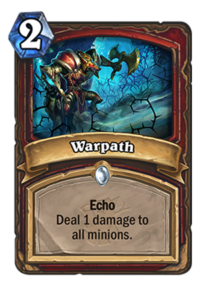
The deck runs quite a lot of different board clears – 2x Warpath, 1x Reckless Flurry, 2x Blood Razor, 2x Brawl and 1x Primordial Drake. However, knowing your enemy is really important, because you want to know which AoEs are best to use and when. Generally, Warpath is the most flexible AoE, so you want to save it as long as possible – it can answer both small and mid-sized minions. You might want to use Reckless Flurry when you still have some Armor – e.g. if you anticipate that your opponent is going to push hard and you will lose the Armor next turn, it might be wise to drop it. Brawl is random, but good in a way that it can clear bigger minions – so if you face a fast deck that has one or two big minions, you might want to save Brawl for them. Primordial Drake’s main advantage is that it comes with a body, but the 2 AoE damage part is important. Try to squeeze it whenever you need a Taunt on top of an AoE.
Keep in mind that most of the Aggro decks have multiple ways to refill their hand and/or the board – using your only AoE against even Paladin when the board isn’t very threatening might not be the best idea, because now he might drop Call to Arms and just refill it.
Phantom Militia is generally a bad early game card, but don’t hesitate to play it as a 2/4 Taunt on Turn 3 if you have no other play. Yes, it’s not optimal, but it’s still much better than skipping your turn. Do not save it until you can play it 2-3 times against Aggro – like I’ve said, your Quest is not a priority anyway.
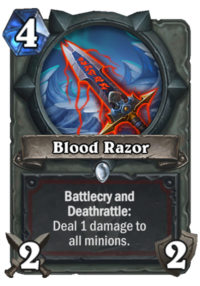
One cool interaction is Blood Razor replacing another Blood Razor (or alternatively, the Quest weapon replacing a Blood Razor). On Turn 8, playing 2x Blood Razor will deal 1 AoE damage 3 times, which can sometimes be useful. The best part about those multiple 1 damage AoEs (so Blood Razor and Warpath) is that they work very well vs Divine Shields and/or Deathrattles. E.g. if your opponent has a board of 2-3 health Murlocs and plays Gentle Megasaur, adapting them with the “Deathrattle: Summon 2x 1/1” option in the late game, you can play Warpath 4 times and clear everything.
So, basically, that is your plan. Keep clearing the board and playing the Taunts. If you draw the Quest you’ve mulliganed away, there is no harm in playing it, you might be able to finish it sometimes. You can also use it to e.g. proc Counterspell against Tempo Mage. However, sometimes you do not want to play the weapon reward – 2 Armor Hero Power might sometimes be better than the 8 damage one, when you’re at very low health in particular. You can still use it as a finisher – weapon hit + Hero Power is 12 damage + whatever you have on the board can add up to ~20 damage or something. Even if your opponent has minions on the board, you still have 5 mana to squeeze in e.g. a Blood Razor or 2x Warpath.
Vs Slow Decks
Your matchups vs slow decks are quite different than those vs fast decks. You could say that at the point where most of the Aggro matchups finish, the REAL game against slow decks start.
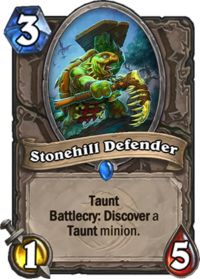
Your #1 priority against slow decks if finishing your Quests. The Taunt minions are generally not very efficient – you don’t put a lot of pressure with them, they should be relatively easy to clear and they don’t give you much value. However, once you finish the Quest, your Hero Power will make up for that. It’s important to try to drop a Taunt minion every turn if you can. Ideally you’d want to finish your Quest around Turn 8-9. Both Stonehill Defender and Phantom Militia are super helpful when it comes to that. When it comes to Stonehill, don’t be too greedy – since your goal is to finish a Quest as quickly as possible, it’s often much better to keep e.g. a Goldshire Footman than for example a Giant Mastodon. The best pick, however, is another Stonehill – you get another +1 on the Quest and can potentially reroll if your other options were bad. If you already have means to finish the Quest in your hand, THEN you might pick some high value card, e.g. another The Lich King or Primordial Drake. Phantom Militia, on the other hand, is a good Turn 6 or Turn 9 play – you don’t have any other 6/9 mana Taunts in this deck anyway, so filling your turn with two/three of them should bring you closer to finishing the Quest, or even finish it.
You play lots of AoE removals, which might not be useful in Control matchups. You might stop playing Taunts and e.g. drop a Brawl or Reckless Flurry in case your opponent develops a solid board. They still come handy against slow decks that want to put minion pressure – such as Even Warlock, where a well-timed Brawl can win you the game. However, I’d say that single target removals are more key against slow decks. You have 4 big single target removals in total, so it’s important to understand how many big threats they run and which take the highest priority. For example, if you have only a single removal in your hand and Even Warlock drops a 6/5, you might want to try to remove it another way, or stall the game with Taunts – save that removal for The Lich King or let’s say a 4/10 Drake that you might not be able to remove other way.
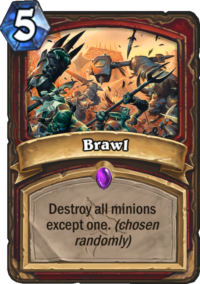
After you finish your Quest, you want to equip the weapon as quickly as possible and start shooting the Hero Power every single turn. I mean it, unless you need full mana or else you would die, shoot it every single turn. However, don’t do that at the beginning of each turn – you want to set up for it first. For example, if you opponent drops a bunch of small minions, you want to AoE them down first. A natural reaction to you finishing the Quest will be playing multiple minions, which you can punish with Brawl.
With your new Hero Power, you no longer want to play the control role. You want to be the beatdown. As much as hitting the face instead of a minion might seem like a low-roll sometimes, you actually WANT the Hero Power to hit your opponent most of the time (unless the choice is between a big minion such as Lich King and face – but hitting face instead of a smaller/midrange minion is usually great). Assuming no healing, all you need is three times 8 damage into their Hero and you can finish the rest with your weapon.
Since you will have 8 more mana to work with every turn, you want to either clear the board (in case of board flood) or drop some Taunts. Taunts should keep you relatively safe for a while, as long as you don’t completely lose the board control. The ideal scenario is putting lots of pressure on your opponent with Hero Power and then dropping some minions. Now he has to both heal himself up, play some minions so your Hero Power won’t hit him again AND deal with your board. Such a situation is often a way to close out the game in such matchups, simply because your opponent won’t be able to do all of that at the same time.
Quest Warrior Card Substitutions
Unlike Control Warrior, a non-Odd Quest Warrior build is actually quite cheap. This specific list costs roughly 5,000 Arcane Dust, which is less than many Aggro decks. However, you might be able to reduce the deck’s cost even further. Let me go through the Legendaries and Epics in this list and offer some potential replacements.
- Fire Plume's Heart – This is the only expensive card that absolutely needs to stay there. The deck makes no sense without it.
- Reckless Flurry & Brawl – Two of your Epic board clears. There are no real, direct replacements for them, and I’d say that you absolutely need at least two copies of big AoEs.
- Shield Slam – It’s actually one of the only builds that runs two copies. You can easily get away with using only a single one – possibly even none.
- Primordial Drake – Big Taunt and AoE in one card, but it’s not absolutely necessary.
And here is the list of potential replacements:
- Second copies of cards that are already in your deck. If you don’t know what to replace your cards with, you can always add second copy of some of the cards that are already in this build – e.g. second Slam or Cornered Sentry in this case!
- Weapon removal. You can use Acidic Swamp Ooze, Gluttonous Ooze or Harrison Jones – each one of those has some merits, but I’d probably lean towards Gluttonous Ooze.
- Whirlwind – Not a great replacement for your AoE cards, but it’s still sometimes useful vs Aggro, and you can use it to activate Execute or draw an extra card from Acolyte of Pain.
- Saronite Chain Gang & Direhorn Hatchling – If you’re looking for more/other Taunt cards. They aren’t amazing, but they’re some of the better mid-game options. Actually, you can use Direhorn Hatchling to replace Rotten Applebaum if you face mostly slow decks – the healing is not that useful and an extra big minion later in the game is generally better.
- The Lich King – Not really a “budget” replacements, but it’s one of the most commonly used Legendary cards, so most of the players have it anyway. It’s a solid late game option in this deck, especially if you face lots of slow decks.
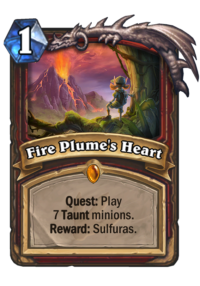


















Could anyone tell me if Cornered Sentry adds 1 or 3 possible target beasts into the Witching Hour pool? (So would playing 2 mean that they have a 1/7 chance of resurrecting Hadronox or does it just create a 50/50 pool of Hadronox vs. Raptor?) This should be obvious but I haven’t been able to really figure it out.
It adds all of them, one sentry played means 1/4, 2 played is 1/7, I even tend to pick one from Stonehill Defender so i would get his pool even bigger, won a few games that way, i think only once in 25~ games against taunt druids he actually revived the hadronox.
This deck is actually very good in the current meta.
Went from rank 10 to 5 with 62% winratio (26-16) as seen here, here’s a picture of the statistics: https://i.imgur.com/6TnzpTr.png
I’d also want to point out that 6 of those losses were in the first 10 games and kind of in a row before I got a hang of how to play this variation of quest warrior. I also had another 6 loss in a row kind of loss streak at rank 7 when I pulled an all nighter and came back HS after 6-7 in the morning after having taken a few hours break with Overwatch so it’s very important that you get into the proper mindset and like get into that rythm in which you take right decisions, pretty similar to when you start a miracle rogue session, you tend to lose a few games before you start racking up wins.
So many of those losses were user error and many were very close games so this is definitely a tier 1 or strong 2 kind of decklist with the current meta. I’d say it’s one of the harder quest warrior decks to pilot and I wouldn’t recommend tossing the quest tbh towards classes that could or be aggro (hunter & pala) since there are so many mid/spell/recruit hunters compared to face/aggro and all sort of midrange paladin stuff not to mention that paladins even if aggro are fairly easy to beat since you draw so many answers before they get scary anyways. As for mulligan, aim for some clear like warpath / weapon vs potential flood the board kind of classes or execute (shield slam aint too bad vs priest either for example), cornered sentry is the most important card vs druid but overall cards 3-drops like stonehill and acolyte are the most important ones to get due to having so many low to medium cost cards so you don’t run out of steam, tar is very useful vs aggro or well anything as well. You can use shield block as well depending on match up since sometimes you have to use it very wisely for reckless or shield slam but again, any card that generate new cards are usually worth keeping around in these kind of decks.
TL;DR – Great deck, it’s not like any other quest warrior I’ve played in the sense of how you pilot it since it’s more like a miracle rogue value play and tempo swing kind of mindset you should have rather than the more classic “block by taunt, block by taunt, block by taunt…. and quest on curve” since you have decent enough of card draw and phantom militia makes it very easy to get out the quest around the time (turn 8-10) you want to get it out.